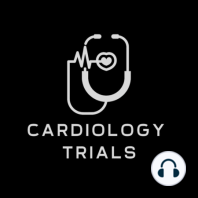7 min listen
Review of the OASIS-5 trial
ratings:
Length:
9 minutes
Released:
Mar 12, 2024
Format:
Podcast episode
Description
N Engl J Med 2006; 354:1464-1476Background: Prior studies showed that combined antiplatelets and anticoagulants reduce ischemic events in patients with acute coronary syndrome but increases the risk of bleeding. We saw this in the FRISC trial where low-molecular-weight heparin plus aspirin reduced the primary endpoint of death or nonfatal myocardial infarction compared to placebo at 6 days but also increased minor bleeding events (8.2% vs 0.3%).Cardiology Trial’s Substack is a reader-supported publication. To receive new posts and support our work, consider becoming a free or paid subscriber.Fondaparinux is a synthetic pentasaccharide that inhibits factor Xa and has a long half-life (17 – 21 hours). In contrast, low-molecular-weight heparin is biologic and has a half-life of 3 - 6 hours.Pilot studies showed that fondaparinux may be as effective as enoxaparin in patients with acute coronary syndrome. The Fifth Organization to Assess Strategies in Acute Ischemic Syndromes (OASIS-5) trial sought to test the hypothesis that in patients with unstable angina or NSTEMI, fondaparinux would be noninferior to enoxaparin in reducing ischemic events but would be associated with less bleeding.Patients: Patients were enrolled if they had at least two of the following criteria: at least 60 years of age, elevated cardiac biomarkers (troponin or creatine kinase MB) or ischemic EKG changes but not ST elevation. Patients were excluded if they had contraindication to low-molecular-weight heparin, recent hemorrhagic stroke or serum creatine of 3 mg/dl or more.Baseline characteristics: The trial enrolled 20,078 patients. The average age of patients was 67 years with 62% being men. About 45% had unstable angina and the rest had NSTEMI. Prior myocardial infarction was present in 26% of the patients, stroke in 6%, heart failure in 14%, hypertension in 67% and diabetes in 25%. About half the patients were active or former smokers.After randomization, about 98% of the patients were on aspirin, 67% were on clopidogrel or ticlopidine, 75% were on ACEi or ARB and 87% were on beta-blockers.During first hospital stay, coronary angiography was performed in 63% of the patients but percutaneous coronary intervention was performed in only 34% and this was similar between both treatment groups. Coronary artery bypass graft (CABG) was performed in 9% in the enoxaparin group and 9.6% in the fondaparinux group.Procedures: The trial was a double-blind, double-dummy trial. Patients were randomly assigned within 24 hours of onset of symptoms to receive fondaparinux at a dose of 2.5 mg once daily plus placebo twice daily or enoxaparin at a dose of 1 mg/ kg twice daily plus placebo once daily. All medications and placebo were administered using subcutaneous injection. Fondaparinux was given until hospital discharge or up to 8 days (whichever occurred first). Enoxaparin was given for 2 – 8 days. Coronary angiogram was permitted at any time.Endpoints: The primary efficacy endpoint was a composite endpoint that included death, myocardial infarction or refractory ischemia at 9 days. The primary safety endpoint was major bleeding. Secondary endpoint included the primary endpoint and its individual components at 30 days and end of the study (up to 180 days).Based on an expected incidence of 8% at 9 days for the primary endpoint and a noninferiority margin of 1.185 for a one-sided alpha level of 2.5%, the estimated sample size was 16,000. However, a blinded review after the first 4,000 patients were enrolled showed a lower than expected event rate. Therefore, the sample size was increased to 20,000 patients.Results: The study randomized 10,057 patients to receive fondaparinux and 10,021 to receive enoxaparin. At 9 days, the primary composite end point occurred in 5.8% patients assigned to fondaparinux and 5.7% patients assigned to enoxaparin (HR: 1.01, 95% CI: 0.90 - 1.13; p= 0.007 for non-inferiority). All components of the primary endpoint were also similar between both trea
Released:
Mar 12, 2024
Format:
Podcast episode
Titles in the series (40)
Review of the Cardiac Arrhythmia Suppression Trial (CAST) by Cardiology Trials
